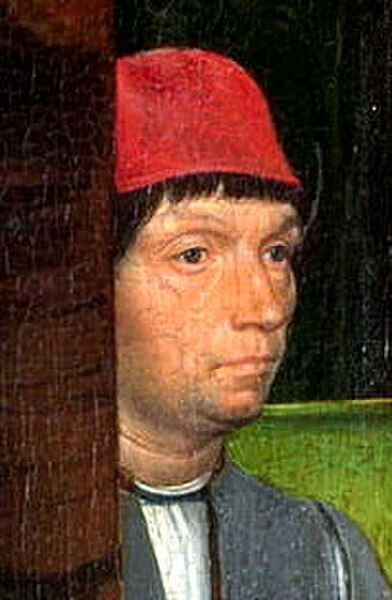Hans Memling was a German-Flemish painter who worked in the tradition of Early Netherlandish painting. Born in the Middle Rhine region, he probably spent his childhood in Mainz. During his apprenticeship as a painter he moved to the Netherlands and spent time in the Brussels workshop of Rogier van der Weyden. In 1465 he was made a citizen of Bruges, where he became one of the leading artists and the master of a large workshop. A tax document from 1480 lists him among the wealthiest citizens. Memling's religious works often incorporated donor portraits of the clergymen, aristocrats, and burghers who were his patrons. These portraits built upon the styles which Memling learned in his youth.
Memling's Self-Portrait at National Gallery, London
Last Judgement, 1466–1473. National Museum, Gdańsk
Scenes from the Passion of Christ, c. 1470, Galleria Sabauda
Triptych of Earthly Vanity and Divine Salvation (front) c. 1485 Oil on oak panel, 22 × 13 cm (each wing) Musée des Beaux-Arts de Strasbourg
Early Netherlandish painting
Early Netherlandish painting is the body of work by artists active in the Burgundian and Habsburg Netherlands during the 15th- and 16th-century Northern Renaissance period, once known as the Flemish Primitives. It flourished especially in the cities of Bruges, Ghent, Mechelen, Leuven, Tournai and Brussels, all in present-day Belgium. The period begins approximately with Robert Campin and Jan van Eyck in the 1420s and lasts at least until the death of Gerard David in 1523, although many scholars extend it to the start of the Dutch Revolt in 1566 or 1568–Max J. Friedländer's acclaimed surveys run through Pieter Bruegel the Elder. Early Netherlandish painting coincides with the Early and High Italian Renaissance, but the early period is seen as an independent artistic evolution, separate from the Renaissance humanism that characterised developments in Italy. Beginning in the 1490s, as increasing numbers of Netherlandish and other Northern painters traveled to Italy, Renaissance ideals and painting styles were incorporated into northern painting. As a result, Early Netherlandish painters are often categorised as belonging to both the Northern Renaissance and the Late or International Gothic.

Rogier van der Weyden, The Descent from the Cross, c. 1435, Museo del Prado, Madrid
Jan van Eyck, The Arnolfini Portrait, 1434, National Gallery, London
The Ghent Altarpiece, completed in 1432 by Hubert and Jan van Eyck. This polyptych and the Turin-Milan Hours are generally seen as the first major works of the Early Netherlandish period.
Hieronymus Bosch, The Garden of Earthly Delights, c. 1490–1510. Museo del Prado, Madrid. Art historians are divided as to whether the central panel was intended as a moral warning or as a panorama of paradise lost.








